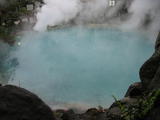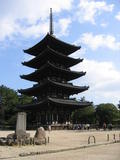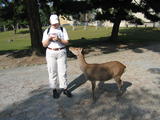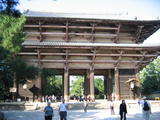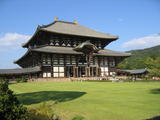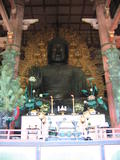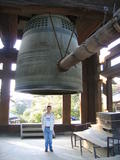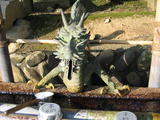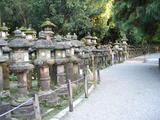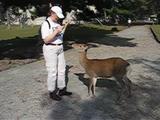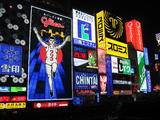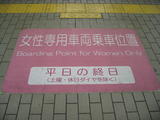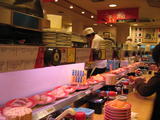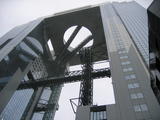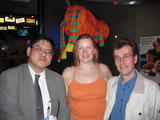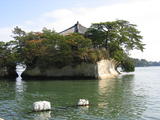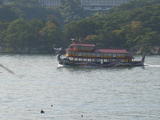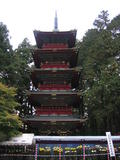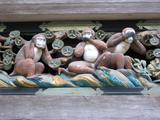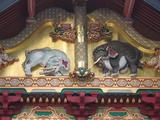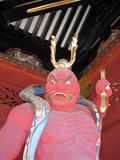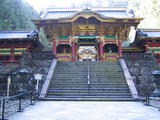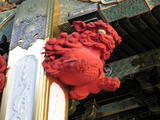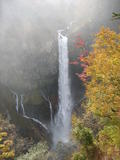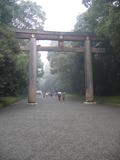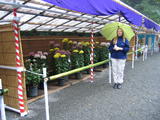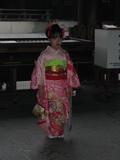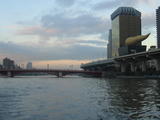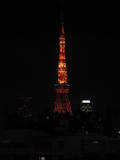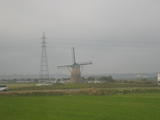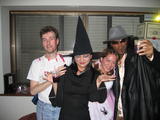| < < < Previous story | Next story > > > | |
Japan part 2: Kyoto, Nara, NikkoHong Kong, November 9th, 2004
Contents:To Osaka via BeppuThe previous travel update ended in Nagasaki. A weekend in Nagasaki is too short to see everything the city has to offer. It is undoubtedly one of the more interesting cities in Japan. On Monday morning we left for Beppu, appropriately described in the Lonely Planet guide as the "Las Vegas" of Japanese spa-resorts. Here we visited the so called "hells", or hot pools, such as Blood Hell which is red and Sea Hell which is blue. After visiting the hells we soaked in some of the onsen, which are Japanese thermal baths. Our stay in Beppu lasted only about half a day, as we had to be in Osaka on Tuesday, to meet Chisako. Two of Japan's most historic cities are close to Osaka, these are Kyoto and Nara. Both have at one point or another been the capital. Some of the best known landmarks are here, such as the largest indoor Buddha in Nara and the Golden Pavilion and Rock Garden in Kyoto. Finding a Long Lost FriendOur stay in Osaka ended on a personal note, as I was lucky to meet a long lost friend. During my previous stay in Japan in 1992, he had helped me a lot, this was a colleague of mine called Tsuru. Unfortunately we had lost contact over the years. But I managed with the help of some other friends to locate him. He had moved to Osaka. It was absolutely great to meet him again, talking with him reminded me of how much he knew about Japan. He seems to know every little detail and he is very good at explaining things. He explained why 4 and 42 are unlucky numbers in Japan. The letters for 4 and 2 in Japanese can be pronounced "shi ni", which closely resembles "shi nin" which could mean "4 persons" but also happens to mean "dead person". So how do you say "4 persons" in Japanese? Well there is alternative way to pronounce 4, it is "yon". This is an important little detail to remember if you want to make reservations for 4 in a restaurant... It all reminded me how lucky I was back in 1992 to have him help me find my way and get accustomed to Japan. He is also one of the kindest and most unselfish persons I have ever met. Telling him that we wanted to see something in northern Japan he suggested Matsushima, which is one of the 3 great sights in Japan. So we used the last few days of our Japan Rail pass to visit Matsushima. There is indeed a beautiful seascape full of islands to admire. Japanese RailwaysWe returned to Tokyo on the last day of our Japan Rail pass, rested a day, and made a two day visit to Nikko. The photos of Nikko below will tell enough about the place. Nikko is best reached using the private Tobu line from Asakusa. The Japan Rail pass is only valid for the lines on the 6 JR companies. But very often a competing private line also runs between two cities, these train lines are usually cheaper than JR lines. The term "private" is a bit inaccurate as Japan Rail itself is now also composed of 6 private rail companies. In total we traveled approximately 3350 km on Shinkansen lines (the bullet trains) and 1300 km on normal lines. Most of this was done using the Japan Rail pass, which therefore was really worth it! What has Changed in JapanAs we left Japan, I thought about what has changed since 1992. On the downside there are now homeless people on the street, a result of the decade long economic slump caused by the inability of successive governments to reform the economy and rekindle growth. But for the foreign traveler a lot of things have improved. More people now seem to understand some English. The Latin alphabet is now used in station and place names nearly everywhere. This certainly was not the case back in 1992. Furthermore, Katakana, the easiest of the three Japanese alphabets, is much more widely used, as it is considered to be a "cool" alphabet. Which is great for someone like me, who made the effort to learn it. Not unimportant either is that Japan has become relatively cheaper, price levels are now comparable or just slightly higher to what they are in Holland, in 1992 things were at least twice as expensive. Many people asked me what the highlight of our trip was. After having thought about this several times, I concluded that it is not a place or a thing to see, but that the highlight is Japan itself, its society and all the things that make it a different, certainly unique experience. If you would like to be notified or no longer want to be notified of travel updates please send me an e-mail. e-mail Otto de Voogd PhotosBeppuNaraNara Deer VideoKyotoOsakaMatsushimaNikkoTokyoHalloweenPractical Information
To my knowledge the information provided here was accurate
at the time of our visit. However time passes and things can change.
TravelProbably the best way to travel around Japan is by train. A Japan Rail pass can be a real bargain if you plan to travel a lot, but it must be bought outside of Japan. It is valid for either 1, 2 or 3 weeks. InformationEvery major station has a good tourist information booth, sometimes a special one for foreigners. They are very helpful and can tell you more or less everything you need to know. CostsJapan - Yen, approx. rates 1 USD = 107 JPG, 1 EUR = 136 JPY
A Japan Rail pass for 2 weeks: 45,100 JPY (363 EUR + 20 EUR costs).
| ||
| < < < Previous story | Next story > > > | |
New | About | Contact | Connect | Friends | Promotions | Copyright | Advertise

